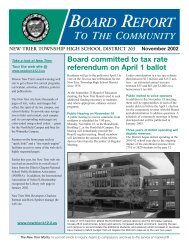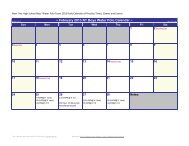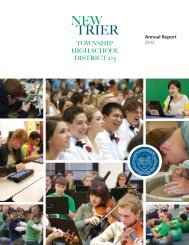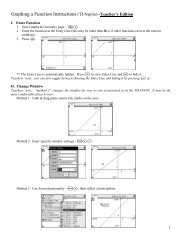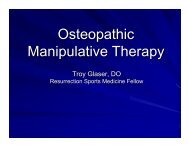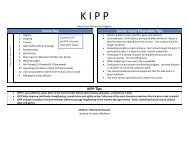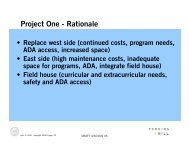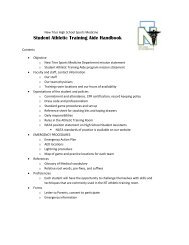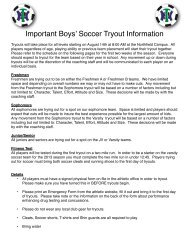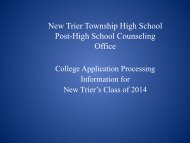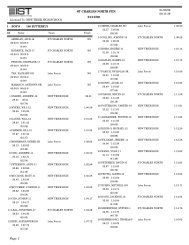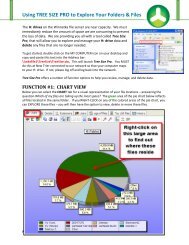HERE - New Trier Township High School
HERE - New Trier Township High School
HERE - New Trier Township High School
You also want an ePaper? Increase the reach of your titles
YUMPU automatically turns print PDFs into web optimized ePapers that Google loves.
Lab Safety Training - RTK<br />
<strong>New</strong> <strong>Trier</strong> <strong>High</strong> <strong>School</strong><br />
Science Department<br />
2010-11
Chemical Hygiene Plan<br />
l The 2010 (revised) <strong>New</strong> <strong>Trier</strong> Science<br />
Department Chemical Hygiene & Safety<br />
Plan is the document that outlines our<br />
department safety program.<br />
l The complete CHP is accessible in the<br />
Science Shared Drive (G:) under<br />
“Chemical Hygiene & Safety.”
What To Look For…<br />
l There are Safety binders in the First<br />
Aid cabinet of each room that lists<br />
location and operation of safety<br />
equipment in that room, and<br />
emergency procedures.<br />
l Safety signage in each room. Is there<br />
something that needs replacement<br />
l Safety check routines are established<br />
and you will be asked to check on<br />
certain items each month.
What To Do…<br />
l Two lab rules that apply to the science<br />
department:<br />
– No food in laboratories. Re-sealable<br />
beverage containers are permitted only in<br />
the classroom section of the room.<br />
– Students who have no scheduled lunch<br />
periods should make arrangements with<br />
other teachers.<br />
– Friday Advisery periods are a special case:<br />
use tablecloths provided and eat only in<br />
the classroom section. Clean up all food<br />
residue prior to 1 st period.
Where Is Safety Information<br />
l We have a Safety File Cabinet in the<br />
Science Office (173 at Winnetka) that<br />
contains other safety resources. It is<br />
near the doorway between 173 and 136.<br />
l The MSDS volumes are still near the<br />
entrance to the department in 173 for<br />
quick access in case of an emergency.
Chemical Labeling<br />
l Flinn<br />
l NFPA<br />
l HMIG<br />
l MSDS
Flinn Chemical Compatibility's<br />
(see detailed example)<br />
l 10 Organic Categories<br />
l 11 Inorganic Categories<br />
l Chemicals segregated by reactivity<br />
l Acids/Bases/Flammables/Poisons stored<br />
in designated cabinets.<br />
l Nitric Acid stored separately<br />
l Volatile substances stored under fume<br />
hoods.
Important Flinn Categories<br />
l Inorganic 1 Metals<br />
l Inorganic 2 Majority of Inorganics<br />
l Inorganic 4 Hydroxides<br />
l Organic 1 Acids<br />
l Organic 2 Alcohols, Carbohydrates<br />
l Organic 9 Indicators
General Categories<br />
l Inorganic M: Boiling stones & Sand<br />
l Organic M: Agars & Culture Media<br />
l Household products stored together in<br />
each prep room as needed.
NFPA<br />
National Fire Protection Association<br />
Flammability<br />
Health<br />
Reactivity<br />
Special Notice<br />
W - Water reactive<br />
ox – Oxidizer<br />
t - Toxic<br />
c - Cancer Risk
NFPA
HMIG<br />
Hazardous Material Identification Guide<br />
l Same categories as NFPA<br />
Health Flammability Reactivity<br />
l Adds icons for Personal Protection
HMIG PPE Icons<br />
Personal Protective Equipment<br />
Vapor<br />
All respirators are stored in 179<br />
If you need something please ask! We will purchase<br />
needed equipment for your protection
Lab Safety Equipment<br />
Lab Safety Equipment<br />
l Know the location and operation of:<br />
– Safety Shower<br />
– Eye wash<br />
– Fire extinguisher(s)<br />
– Fire blanket<br />
– First aid cabinet<br />
– Emergency gas & water shutoffs (Electric is GFI)<br />
l Do you have any questions about the<br />
operations of safety equipment in your lab<br />
Ask Elaine Kollar, Mary Beth Barrett, or<br />
Nicole Hoefling.
l<br />
MSDS<br />
Material Safety Data Sheets<br />
Available in 173 and Online – Bookmark as a<br />
favorite for easy access or create a desktop<br />
shortcut.<br />
http://www.flinnsci.com/search_MSDS.asp<br />
http://www.msdssearch.com/<br />
http://msds.pdc.cornell.edu/msdssrch.asp
1<br />
23<br />
4<br />
5<br />
1 - Name<br />
2 - Hazard Rating<br />
3 - C.A.S./synonyms<br />
4 - Health Hazard<br />
5 - First Aid<br />
6 - Spill<br />
7 - PPE<br />
6<br />
7
MSDS and Health Services<br />
l Health Services requests that we have in<br />
our possession, during each laboratory<br />
experiment, paper copies of the MSDS’s.<br />
Timely medical treatment is essential,<br />
and having MSDS copies immediately<br />
available in the lab room which outline<br />
specific treatments will provide medical<br />
personnel the information they need.<br />
These copies can be kept in your folder or<br />
lesson plans so they can be retrieved<br />
immediately upon an accident occurring.
Chemical Inventory & Storage
Organization of Chemicals<br />
• The Flinn Scientific system of labeling<br />
chemicals and shelving is used<br />
throughout the department.<br />
• The system separates chemicals into<br />
groups (I#1, I#2, O#1, etc.) that do not<br />
react with each other. Groups that do<br />
react with each other are then physically<br />
separated in the storage rooms.
Where’s s Waldo<br />
l<br />
l<br />
l<br />
l<br />
Refer to the Flinn catalog for the group<br />
designation.<br />
Familiarize yourself with the storerooms.<br />
Ask for help in locating chemicals.<br />
A current inventory is on our Science Shared<br />
drive (G drive) under “Chemical Hygiene &<br />
Safety.”
Designated Chemical Storage<br />
Winnetka<br />
l 164a Inorganics<br />
l 161a Organics and Indicators; Inorganics for use by teachers<br />
in adjacent rooms<br />
l Household chemicals – stored in most prep rooms<br />
l Basement - Liquid Overstock<br />
l All storage rooms and labs may also contain commonly used<br />
chemicals and chemicals in lab setups<br />
l Two locked poison cabinets in 161a & 164a<br />
l Radioactive samples are in a file cabinet in 164a. Please<br />
keep radioactive samples in the bottom drawer, and<br />
detectors in the top drawer.<br />
Northfield<br />
l 2 central storerooms on the 2 nd and 3 rd floors
Extremely Hazardous Materials<br />
While all chemicals have the potential to be<br />
hazardous, the following categories of<br />
chemicals are considered extremely hazardous.<br />
No materials should be used unless the<br />
educational value outweighs the risk. Always<br />
overestimate the dangers of chemicals.<br />
l Explosives - e.g., Ethyl Ether<br />
l Poisons - e.g., Bromine<br />
l Carcinogens - e.g., Cadmium & Cd salts<br />
l Caustics - e.g., Concentrated Acids<br />
l Flammables - e.g., Sodium (metal)<br />
l Irritants - e.g., Butyric Acid
Chemical Disposal<br />
l Check Flinn Catalog for appropriate<br />
disposal if a substance cannot be<br />
neutralized.<br />
l Collect hazardous waste and label with<br />
“Discard” sheet: chemical names, your<br />
name, and date – Ask for information<br />
and/or disposal help.<br />
l Waste is removed usually every other<br />
year with PPS and Art Department waste
Summary<br />
l Read MSDS before handling chemicals.<br />
l Have MSDS in lab<br />
l Teach students how to read labels.<br />
l Learn Flinn storage.
Equipment Use & Safety<br />
l Maintain equipment by inspecting<br />
cords, moving parts, etc.<br />
l Identify with your name and tag broken<br />
equipment<br />
l Notify Science Lab Supervisor or PPS<br />
for repair.
Fire Safety<br />
l Think safety for people first!!!<br />
l Evacuate the area<br />
l Notify the fire department (Dial 911 or<br />
PPS or pull box if necessary)<br />
l Small fires: use fire extinguishers<br />
l On people: use fire blankets
Fire Extinguishers<br />
l<br />
l<br />
l<br />
Our labs contain ABC Dry Chemical<br />
extinguishers.<br />
ABC or Multi-Purpose extinguisher utilize a<br />
specially fluidized and siliconized mono<br />
ammonium phosphate dry chemical.<br />
– It chemically insulates Class A fires by melting at<br />
approximately 350°F and coats the surface to which<br />
it is applied.<br />
– It smothers and breaks the chain reaction of Class B<br />
fires and will not conduct electricity back to the<br />
operator.<br />
If you are working with burning metals, a Class<br />
D (164a) or bucket of sand should be in your<br />
lab.
Using a Fire Extinguisher<br />
l Remember PASS<br />
–Pull the pin<br />
–Aim at the base of the fire<br />
–Squeeze the lever slowly<br />
–Sweep from side to side
How to Use a Fire Extinguisher<br />
Pull the pin…<br />
This will allow<br />
you to<br />
discharge the<br />
extinguisher<br />
Environmental Health & Safety Dept.
How to Use a Fire Extinguisher<br />
Aim at the base of the fire…<br />
Hit the fuel.<br />
If you aim at<br />
the flames...<br />
… the extinguishing agent will fly right<br />
through and do no good.<br />
Environmental Health & Safety Dept.
How to Use a Fire Extinguisher<br />
Squeeze the top handle…<br />
This depresses a<br />
button that<br />
releases the<br />
pressurized<br />
extinguishing<br />
agent.<br />
Environmental Health & Safety Dept.
How to Use a Fire Extinguisher<br />
Sweep from side to side…<br />
.. until the fire is<br />
completely out.<br />
Start using the extinguisher<br />
from a safe distance away,<br />
then slowly move forward.<br />
Once the fire is out, keep an eye on the area in case<br />
it re-ignites.<br />
Environmental Health & Safety Dept.
First Aid<br />
l You are responsible to provide aid to<br />
the level of your training. For example,<br />
if you are CPR certified you are<br />
expected to use your talents.<br />
l If there is blood, be sure to contact the<br />
nurse and/or send the student to<br />
Health Services. Use the phone in the<br />
lab.<br />
l First aid cabinets are in all labs – check<br />
for supplies regularly. (e.g., the Quik-<br />
Chlor Kit and Band aids)
Reminders<br />
l You are a science educator and<br />
professional who is responsible to look<br />
up and determine safety risks for<br />
yourself and your students.<br />
l If you do not know something, ask<br />
questions and research answers
Sign Off<br />
l By completing this process online you<br />
will sign off as having completed this<br />
year’s safety training<br />
l Throughout the year you will receive<br />
safety information during department<br />
meetings that you are expected to read.<br />
If you have any questions or concerns<br />
please talk to Elaine, Mary Beth, Nicole,<br />
Robyn, or Gerry.



